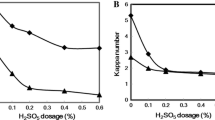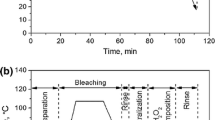Abstract
The bleaching of wood fibres using hydrogen peroxide is the primary process to produce paper with suitable brightness. Several studies were made to define the hydrogen peroxide consumption and the brightness gain rate. However, the effectivity of the hydrogen peroxide towards the reaction with the chromophores in the fibres and not lost by decomposition reactions has not been studied in detail before. In the presented research, three of the most common wood fibre types used in the paper industry were bleached using a hydrogen peroxide sequence composed of five subsequent stages, each with the same amount of hydrogen peroxide. The total consumption of the bleaching agent was measured by applying an adaptation to the commercial procedure developed by Merck KGaA using the Reflectoquant® apparatus. The corresponding electron exchange was calculated using the Kappa number to estimate the amount of hydrogen peroxide effectively consumed by reaction with the chromophores present in the lignin. In this case, it was observed that the decomposition reactions are significant with respect to the bleaching reactions. In all cases, this approach allowed to differentiate between the amount of hydrogen peroxide consumed by bleaching and the amount lost by decomposition under the applied assumptions.
Graphical abstract








Similar content being viewed by others
References
Arce C, Llano T, García P, Coz A (2020) Technical and environmental improvement of the bleaching sequence of dissolving pulp for fibre production. Cellulose 27:4079–4090
Belgacem N, Pizzi A (2016) Lignocellulosic fibres and wood handbook renewable materials for today’s environment. Wiley, Hoboken
Chai XS, Hou QX, Luo Q, Zhu JY (2004) Rapid determination of hydrogen peroxide in the wood pulp bleaching streams by a dual-wavelength spectroscopic method. Anal Chim Acta 507:281–284
Colombo Dugoni G, Mezzetta A, Guazzelli L, Chiappe C, Ferro M, Mele A (2020) Purification of Kraft cellulose under mild conditions using choline acetate based deep eutectic solvents. Green Chem 22:8680–8691
Danielewicz D, Surma-Ślusarska B (2017) Properties and fibre characterisation of bleached hemp, birch and pine pulps: a comparison. Cellulose 24:5173–5186
Ek M, Gellerstedt G, Henriksson G (2009) Pulping chemistry and technology, vol 2. De Gruyter, Berlin, Germany
European Commission (2020) Climate-neutral Europe by 2050. https://ec.europa.eu/clima/policies/strategies/2050_en. Accessed 21 Jan 2020
Franchini RAA, De Souza CF, Colombara R, Matos MAC, Matos RC (2007) Rapid determination of hydrogen peroxide using peroxidase immobilized on amberlite IRA-743 and minerals in honey. J Agric Food Chem 55:6885–6890
Garver TM Jr., Robson C, Evans M (2001) Measurement and control of peroxide bleaching indicators, Report, 2001. http://www.paperage.com/peroxide.pdf. Accessed 25 July 2020
Gierer J (1986) Chemistry of delignification part 2: reactions of lignins during bleaching. Wood Sci Technol 20:1–33
Hanson RW (1990) Oxidation states of carbon as aids to understanding oxidative pathways in metabolism. Biochem Educ 18(4):194–196
Heitner C, Dimmel DR, Schmidt JA (2010) Lignin and lignans: advances in chemistry. Taylor and Francis Group, Boca Raton, USA
Holik H (ed) (2013) Handbook of paper and board, vol 1. Wiley-VCH Verlag GmbH & Co., Germany
ISO 5351:2010 (2010) Pulps—Determination of limiting viscosity number in cupri-ethylenediamine (CED) solution
ISO 2470–1:2016 (2016) Paper, board and pulps—Measurement of diffuse blue reflectance factor—Part 1: indoor daylight conditions (ISO brightness)
Kadla JF, Chang H, Jameel H (1997) The reactions of lignins with hydrogen peroxide at high temperature: part I. Oxid Lignin Model Compd Holzforsch 51:428–434
Martin J, Haggith M (2018) State of the Global paper industry. Environmental paper network https://environmentalpaper.org/wp-content/uploads/2018/04/StateOfTheGlobalPaperIndustry2018_FullReport-Final-1.pdf. Accessed 1 Jan 2020
Method MQuant® (2019) Colorimetric with test strips 1–3–10–30–100 mg/L H2O2 MQuant®. Instructions http://www.merckmillipore.com/BE/en/product/PeroxideTest.MDA_CHEM110081?ReferrerURL=http%3A%2F%2Fwww.emdmillipore.com%2FUS%2Fen%2Fproduct%2FPeroxideTest%2CMDA_CHEM-110081#anchor_PI. Accessed 15 Oct 2019
Moßhammer M, Kühl M, Koren K (2017) Possibilities and challenges for quantitative optical sensing of hydrogen peroxide. Chemosensors 5:28
Olenin AY (2017) Methods of nonenzymatic determination of hydrogen peroxide and related reactive oxygen species. J Anal Chem 72(3):243–255
Popa. VI (2013) Pulp production and processing. Smithers Rapra Technology Ltd. Shropshire. United Kingdom
Pundir CS, Deswal R, Narwal V (2018) Quantitative analysis of hydrogen peroxide with special emphasis on biosensors. Bioprocess Biosyst Eng 41:313
Reflectoquant® (2017) RQflex®20 reflectometer, supelco® analytical products. Operating manual 10/2017
Sixta H (2006) Handbook of pulp. WILEY-VCH Verlag GmbH & Co, KGaA, Weinheim, Germany
Suess HS (2010) Pulp bleaching today. De Gruyter, Berlin, Germany
Sun X, Hou Q (2018) Iso-concentration hydrogen peroxide bleaching of poplar chemi-thermomechanical pulp. J Bioresour Bioprod 3(1):35–39
Tappi procedure (1999) T 236 om-99, Kappa number of pulp
Testova L, Borrega M, Tolonen LK, Penttilä PA, Serimaa R, Larsoon PT, Sixta H (2014) Dissolving-grade birch pulps produced under various prehydrolysis intensities: quality, structure and applications. Cellulose 21:2007–2021
Wang N, Tang P, Zhao C, Zhang Z, Sun G (2020) An environmentally friendly bleaching process for cotton fabrics: mechanism and application of UV/H2O2 system. Cellulose 27:1071–1083
Zhang Q, Fu S, Li H, Liu Y (2013) A novel method for the determination of hydrogen peroxide in bleaching effluents by spectroscopy. BioResources 8(3):3699–3705
Acknowledgements
This study was supported by research funding from Flanders Innovation & Entrepreneurship (VLAIO) (Pr. Nr. IWT.155050) and the University of Antwerp.
Author information
Authors and Affiliations
Corresponding author
Ethics declarations
Conflict of interest
The authors declare that they have no conflict of interest.
Additional information
Publisher's Note
Springer Nature remains neutral with regard to jurisdictional claims in published maps and institutional affiliations.
Rights and permissions
About this article
Cite this article
Tofani, G., Cornet, I. & Tavernier, S. Estimation of hydrogen peroxide effectivity during bleaching using the Kappa number. Chem. Pap. 75, 5749–5758 (2021). https://doi.org/10.1007/s11696-021-01756-y
Received:
Accepted:
Published:
Issue Date:
DOI: https://doi.org/10.1007/s11696-021-01756-y




